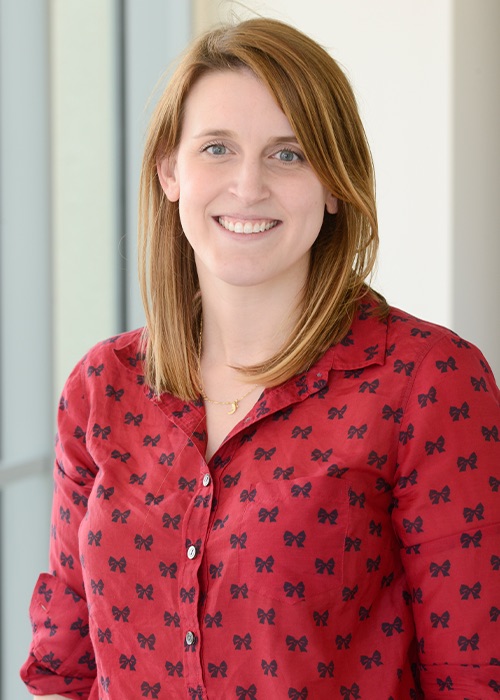UT Southwestern leads national efforts around childhood blood disorders
Studies highlight how collaborative research can improve the diagnosis and treatment of aplastic anemia and MDS

DALLAS – Oct. 15, 2020 – When a child has a rare blood disorder, clinicians can struggle to find the best diagnostic and treatment methods. New research led by UT Southwestern shows the effectiveness of a treatment for aplastic anemia and reveals the range of diagnosis and treatment options used by hospitals around the country for a related disease – myelodysplastic syndrome (MDS).
Two studies, published recently in Pediatric Blood & Cancer and conducted as part of the North American Pediatric Aplastic Anemia Consortium (NAPAAC), show the benefit of collaboration in studying childhood blood disorders.

“At UT Southwestern, we’re trying to push forward the diagnostic approach and treatment options for these rare blood disorders,” says Kathryn E. Dickerson, M.D., M.S., an assistant professor of pediatric hematology-oncology at UTSW, pediatric hematologist and oncologist at Children’s Health and a lead author of the two papers. “But with these kinds of rare diseases, you really have to be willing to come together with institutions around the country and work as a group to make progress.”
Aplastic anemia occurs when the body’s immune system attacks the stem cells in the bone marrow that usually produce blood cells. This results in the bone marrow making too few red blood cells that carry oxygen through the body, white blood cells that help fight infections, and platelets that aid in blood clotting. Children with aplastic anemia are often tired, pale, unable to tolerate their normal activities, and get frequent infections and bruises. Only two treatments have been shown to work: a bone marrow transplant or immune system suppression therapy.
Typically, bone marrow transplants are only carried out in children with aplastic anemia if they have a sibling who is a match or if they’ve failed immune suppression therapies and doctors can find an unrelated donor. That’s because receiving bone marrow cells from an unrelated donor is more likely to lead to complications. But in recent years, approaches to minimize these complications have improved. So Dickerson and her NAPAAC collaborators wanted to know whether bone marrow transplants from unrelated donors is now a more viable treatment option – even for children who haven’t tried immune suppression yet.
For the study, Dickerson and her collaborators randomized 21 children under the age of 26 with newly diagnosed severe aplastic anemia to receive either a bone marrow transplant from an unrelated donor or the typical standard-of-care immune-suppressive therapy. The patients, who were located at nine different hospitals around the country, were then followed for an average of 18 months.
Ten of the 12 patients randomized to receive a bone marrow transplant were able to find a matched, unrelated donor within eight weeks. Four months after treatment, there was no statistical difference in the number of patients from each treatment group who had recovered from aplastic anemia; seven of 11 patients treated with immune suppression had healthy levels of blood cells and six of the 10 patients who had received transplants had fully recovered. On average, patients treated with immune suppression recovered in 82.5 days and patients who received a transplant recovered in 62 days.
“What we showed in this pilot study is that we’re certainly not putting patients at any increased harm by proceeding to a transplant instead of immune suppression,” says Dickerson, also clinical program director of bone marrow failure and leukemia predisposition at Children’s Health. “That finding lets us now start planning a larger, randomized phase 3 trial to try to show that a transplant would be a superior first-line treatment option to immune suppression.”
In a second paper, Dickerson and another group of NAPAAC collaborators surveyed North American medical centers about their approaches to diagnosing, treating, and managing MDS.
In MDS, similar to aplastic anemia, the body has a shortage of mature blood cells. However, there is no shortage of bone marrow stem cells; instead, these stem cells fail to mature normally. In the past, MDS was sometimes called “pre-leukemia” since children with MDS are more likely to go on to develop leukemia.
Currently, there’s no standardized approach to how clinicians in North America diagnose and treat MDS, Dickerson says. Patients often go undiagnosed for months as their doctors struggle to pin down exactly what they have. To be treated, patients typically must visit a major medical center with pediatric cancer specialists and specially trained pathologists.
The survey carried out by Dickerson and her collaborators was a step toward developing widespread standards on MDS to help guide doctors in diagnosing the rare disease and assist large medical centers to collaborate on similar guidelines.
The team sent a survey to all 35 NAPAAC institutions known to treat MDS; 28 completed the survey. While diagnostic criteria were fairly standard among institutions, the survey revealed a wide range of treatment standards used to manage MDS.
“We have a goal of a national patient registry and collaborative studies where we can look at treatment for MDS in a standardized way,” says Dickerson. “But right now, our survey showed that people are really doing different one-off combinations of things without any infrastructure.”
The survey results, Dickerson hopes, will help the NAPAAC MDS working group move toward its goal of clinical guidelines to treat patients with MDS more quickly and effectively.
Collaborators on the bone marrow transplantation paper were Michael Pulsipher and Cindy Zhuang of Children’s Hospital Los Angeles; Leslie Lehmann, Maggie Malsch, Mark Fleming, Edie Weller, Akiko Shimamura and David Williams of Boston Children’s Hospital and Harvard Medical School; Alison Bertuch and Ghadir Sasa of Texas Children’s Hospital and Baylor College of Medicine; Timothy Olson of Children’s Hospital of Philadelphia; Taizo Nakano of Children’s Hospital Colorado; Alfred Gilio of Pediatric Hematology & Oncology; Lauri Burroughs of Fred Hutchinson Cancer Research Center and the University of Washington; Jeffrey Lipton of Cohen Children’s Medical Center; James Huang of University of California, San Francisco; and Alice Bertaina of Stanford School of Medicine.
The bone marrow transplantation research was supported by funds from the National Institutes of Health (5R34HL133384, UG1HL069254, HL122173, DK099808) and the Campini Foundation.
Collaborators on the MDS paper were Taizo Nakano and Kristen Campbell of University of Colorado, Bonnie Lau of Dartmouth Geisel School of Medicine, Marcin Wlodarski of St. Jude Children’s Research Hospital, Jessica Pollard and Akiko Shimamura of Boston Children’s Hospital and Harvard Medical School, Inga Hofmann of University of Wisconsin, Ghadir Sasa and Tarek Elghetany of Texas Children’s Hospital and Baylor College of Medicine, Michaela Cada and Yigal Dror of The Hospital for Sick Children, Hilda Ding of Rady Children’s Hospital, Steven Allen of University of Pittsburgh, Rabbi Hanna of Taussing Cancer Institute, and Timothy Olson of Children’s Hospital of Philadelphia.
About UT Southwestern Medical Center
UT Southwestern, one of the premier academic medical centers in the nation, integrates pioneering biomedical research with exceptional clinical care and education. The institution’s faculty has received six Nobel Prizes, and includes 23 members of the National Academy of Sciences, 16 members of the National Academy of Medicine, and 13 Howard Hughes Medical Institute Investigators. The full-time faculty of more than 2,500 is responsible for groundbreaking medical advances and is committed to translating science-driven research quickly to new clinical treatments. UT Southwestern physicians provide care in about 80 specialties to more than 105,000 hospitalized patients, nearly 370,000 emergency room cases, and oversee approximately 3 million outpatient visits a year.
